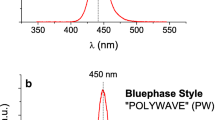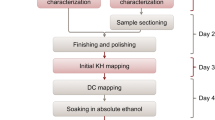Abstract
This in vitro study compared the depth of cure obtained with six quartz tungsten halogen and light-emitting diode curing units at different exposure times and light tip-resin composite distances. Resin composite specimens (Tetric Ceram, A3; diameter 4 mm, height 6 mm) were exposed from 0-, 3-, and 6-mm distance. The curing units (200–700 mW/cm2) were used for standard (20 and 40 s), pulse-delay mode (initial exposure of 3 s at 200 mW/cm2, followed by a resting period of 3 min and a final exposure of 10 or 30 s at 600 mW/cm2), or soft-start curing (40 s; exponential ramping). Curing depth was determined by measurement of Wallace hardness for each half millimeter starting at 0.5 mm from the top surface. For each specimen, a mean HW value was calculated from the HW values determined at the depths of 2.0 mm and less (0.5, 1.0, 1.5, and 2.0 mm, respectively). The depth of cure for each specimen was found by determining the greatest depth before an HW value exceeding the minimal HW value by 25% occurred. For all curing units, an increase in exposure time led to significantly higher depth of cure. Increasing the light tip-resin composite distance significantly reduced the depth of cure. With a light tip-resin composite distance of 6 mm, median values of depth of cure varied between 2.0 and 3.5 mm following a 20-s (or 3+10 s) exposure and between 3.0 and 4.5 mm following a 40-s (or 3+30 s) exposure. The composite situated above the depth of cure value cured equally well with all curing units. At both exposure times, Luxomax resulted in the significantly lowest depth of cure, and Astralis 7 yielded significantly higher depth. At both exposure times, a significant linear correlation was found between the determined power densities of the curing units and the pooled depth of cure values obtained. It seems that for the resin composite tested, the recommended exposure time of 40 s per 2-mm increment may be reduced to 20 s, or that increments may be increased from 2 to 3.5 mm. It may be that the absolute values of depth of cure found are material specific, but we believe that the relationships found between curing units, between exposure times, and between light guide distances are universal.

Similar content being viewed by others
References
Asmussen E (1982) Restorative resins: hardness and strength vs quantity of remaining double bonds. Scand J Dent Res 90:484–489
Asmussen E, Peutzfeldt A (2001) Influence of pulse-delay curing on softening of polymer structures. J Dent Res 80:1570–1573
Bruning JL, Kintz BL (1997) Computational handbook of statistics. Longman, New York
Burgess JO, Walker RS, Porche CJ, Rappold AJ (2002) Light curing—an update. Comp Cont Ed 23:889–906
Caughman WF, Caughman GB, Shiflett RA, Rueggeberg F, Schuster GS (1991) Correlation of cytotoxicity, filler loading and curing time of dental composites. Biomaterials 12:737–740
Caughman WF, Rueggeberg FA, Curtis JW (1995) Clinical guidelines for photocuring restorative resins. J Am Dent Assoc 126:1280–1286
Caughman WF, Rueggeberg FA (2002) Shedding new light on composite polymerization. Oper Dent 27:636–638
Cunha LG, Sinhoreti MA, Consani S, Sobrinho LC (2003) Effect of different photoactivation methods on the polymerization depth of a light-activated composite. Oper Dent 28:155–159
Davidson CL, Feilzer AJ (1997) Polymerization shrinkage and polymerization shrinkage stress in polymer-based restoratives. J Dent 25:435–440
Dunn WJ, Bush AC (2002) A comparison of polymerization by light emitting diode and halogen-based light curing units. J Am Dent Assoc 133:335–341
Feilzer AJ, Dooren LH, de Gee AJ, Davidson CL (1995) Influence of light intensity on polymerization shrinkage and integrity of restoration–cavity interface. Eur J Oral Sci 103:322–326
Ferracane JL (1985) Correlation between hardness and degree of conversion during the setting reaction of unfilled dental restorative resins. Dent Mater 1:11–14
Hackman ST, Pohjola RM, Rueggeberg FA (2002) Depth of cure and effect of shade using pulse-delay and continuous exposure photo-curing techniques. Oper Dent 27:593–599
Hald A (1952) Statistical theory with engineering applications. Wiley International Edition, New York
Harrington E, Wilson HJ (1993) Depth of cure of radiation-activated materials—effect of mould material and cavity size. J Dent 21:305–311
Hofmann N, Hiltl O, Hugo B, Klaiber B (2002) Guidance of shrinkage vectors vs irradiation at reduced intensity for improving marginal seal of class V resin-based composite restorations in vitro. Oper Dent 27:510–515
Jandt KD, Mills RW, Blackwell GB, Ashwoth SH (2000) Depth of cure and compressive strength of dental composites cured with blue light emitting diodes (LEDs). Dent Mater 16:41–47
Kanca J, Suh BI (1999) Pulse activation: reducing resin-based composite contraction stresses at the enamel cavosurface margins. Am J Dent 12:107–112
Knezevic A, Tarle Z, Meniga A, Sutalo J, Pichler G, Ristic M (2001) Degree of conversion and temperature rise during polymerization of composite resin samples with blue diodes. J Oral Rehabil 28:586–591
Lindberg A, Peutzfeldt A, van Dijken JWV (2004) Curing depths of a universal hybrid and flowable resin composite cured with quartz tungsten halogen and light-emitting diode units. Acta Odontol Scand 62:97–101
Meyer GR, Ernst C-P, Willershausen B (2002) Decrease in power output of new light-emitting diode (LED) curing devices with increasing distance to filling surface. J Adhes Dent 4:197–204
Mills RW, Jandt KD, Asworth SH (1999) Dental composite depth of cure with halogen and blue light emitting diode (LED) technology. Br Dent J 186:388–391
Park SH, Krejci I, Lutz F (2002) Microhardness of resin composites polymerized by plasma arc or conventional visible light curing. Oper Dent 27:30–37
Peutzfeldt A, Asmussen E (2000) The effect of postcuring on quantity of remaining double bonds, mechanical properties, and in vitro wear of two resin composites. J Dent 28:447–452
Pianelli C, Devaux J, Bebelman S, Leloup G (1999) The micro-Raman spectroscopy, a useful tool to determine the degree of conversion of light-activated composite resins. Biomed Mater Res 48:675–681
Price RB, Dérand T, Sedarous M (2000) Effect of distance on the power density from two light guides. J Esthet Dent 12:320–327
Rueggeberg FA, Caughman WF, Curtis JW, Davis HC (1993) Factors affecting cure at depths within light-activated resin composites. Am J Dent 6:91–95
Rueggeberg FA, Jordan DM (1993) Effect of light-tip distance on polymerization of resin composite. Int J Prosthodont 6:364–370
Rueggeberg FA, Caughman WF, Curtis JW Jr (1994) Effect of light intensity and exposure duration on cure of resin composite. Oper Dent 19:26–32
Rueggeberg FA, Caughman WF, Chan DN (1999) Novel approach to measure composite conversion kinetics during exposure with stepped or continuous light-curing. J Esthet Dent 11:197–205
Rueggeberg FA, Ergle JW, Mettenburg DJ (2000) Polymerization depths of contemporary light-curing units using microhardness. J Esthet Dent 12:340–349
Ruyter IE, Öysaed H (1982) Conversion in different depth of ultraviolet and visible light activated composite materials. Acta Odontol Scand 40:179–192
Shortall AC, Harrington E (1998) Temperature rise during polymerization of light-activated resin composites. J Oral Rehabil 25:908–913
Tarle Z, Meniga A, Knežević A, Šutalo J, Ristić M, Pichler G (2002) Composite conversion and temperature rise using a conventional, plasma arc, and an experimental blue LED curing unit. J Oral Rehabil 29:662–667
Uno S, Asmussen E (1991) Marginal adaptation of a restorative resin polymerized at reduced rate. Scand J Dent Res 99:440–444
Unterbrink GL, Muessner R (1995) Influence of light intensity on two restorative systems. J Dent 23:118–183
Venhoven BAM, de Gee AJ, Davidson CL (1993) Polymerization contraction and conversion of light-curing BisGMA-based methacrylate resins. Biomaterials 14:871–875
Acknowledgements
This study was supported in part by the County Council of Västerbotten and the University of Umeå. We are grateful to the manufacturers for supplying us with the curing units and resin composite.
Author information
Authors and Affiliations
Corresponding author
Rights and permissions
About this article
Cite this article
Lindberg, A., Peutzfeldt, A. & van Dijken, J.W.V. Effect of power density of curing unit, exposure duration, and light guide distance on composite depth of cure. Clin Oral Invest 9, 71–76 (2005). https://doi.org/10.1007/s00784-005-0312-9
Received:
Accepted:
Published:
Issue Date:
DOI: https://doi.org/10.1007/s00784-005-0312-9




